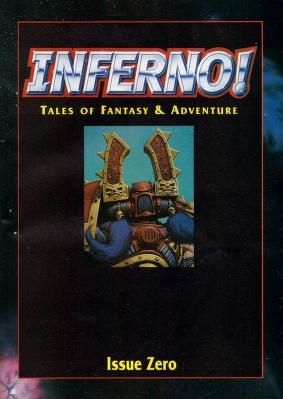Sit down and strap in, folks, we’ve got a big one for you today in our ongoing series on the history of the Black Library (from the Warhammer 40,000 perspective). Let’s dive right in!
Our Story So Far
The Black Library as we know it today had its formal christening in 1997, the brainchild of three men at Games Workshop: Rick Priestly, Andy Jones, and Marc Gascoigne. Priestly was the group’s elder statesman, co-creator of Warhammer Fantasy Battles and Warhammer 40,000. Jones had worked his way up in the company, a trajectory that took him from frontline telesales to marketing and events. Gascoine, meanwhile, had left the company in the mid-80’s after some games development and editing work, but returned to help kick off the publishing arm.
The Black Library’s launch venture was to be a bi-monthly magazine, Inferno!, a vehicle for publishing Warhammer fiction, comics, and other content. In our previous installment we looked at the path to bringing the Black Library to life. Today, we’ll explore the fruits of that labor, the four Issues of Inferno! that were published in that foundational year, 1997.
ISSUE #0: JUNE 1997
Inferno! was unleashed upon the world within the pages of White Dwarf 210, landing in June. “In case you hadn’t noticed,” said ‘Supreme Commander’ Andy Jones in his inaugural editor’s address, “you’ve just turned over a White Dwarf page the likes of which has never been seen before.”
This offering would be “packed with stories from the worlds of Warhammer and Warhammer 40,000,” he promised. “Stories about mighty heroes, impossible adventures, historical events, important places, fabulous myths, famous battles, powerful objects, mystical artifacts, and anything else exciting which comes to mind.”
Nor was Inferno! limiting itself just to prose. “By ‘stories’,” he continued, “I don’t just mean words on a page- a tale can be told by a comic strip, a series of maps and charts, or even by a single illustration.” This was, perhaps, a bit of foreshadowing; the following year would see the launch of Warhammer Monthly, a separate anthology of stories told in the comic format.
White Dwarf readers, of course, would learn this only in time, but had plenty to keep them excited in the present- including a short story by Jonathan Green.
The Hounds of Winter, by Jonathan Green
By this point, Green had already established himself as a writer for the Fighting Fantasy series of gamebooks created by Steve Jackson and Ian Livingstone. He had a trio of them under his belt and would eventually go on to pen five more- as well as a history of the series.
In addition to working as a teacher full-time Green was a color text writer for Games Workshop, having contributed short mini-stories for various rulebooks and codices. Jones had already lined him up for a story for Issue #1, Salvation, and was impressed enough with his work that he asked for an additional story for the preview issue. Highlightijng his versatility, Green delivered with a tale from the Fantasy side.
The Hounds of Winter featured a band of Kislevite mercenaries led by Torben Badenov. This marked the first time we’d see a character introduced in a Black Library short story that would later go on to debut in a novel (2002’s The Dead and the Damned).
Green remains one of the few members of the inaugural class of writers whose career is nearly as long as the Black Library itself with six novels, a score of short stories, and plenty of comic work under his belt. His most recent piece for the Black Library is Krakenbane’s Curse, an Age of Sigmar short story that was part of the Age of Sigmar eShorts Week in October of 2023.
His name has also graced fiction for a number of other properties, from Doctor Who to Judge Dredd, Star Wars to the Teenage Mutant Ninja Turtles.
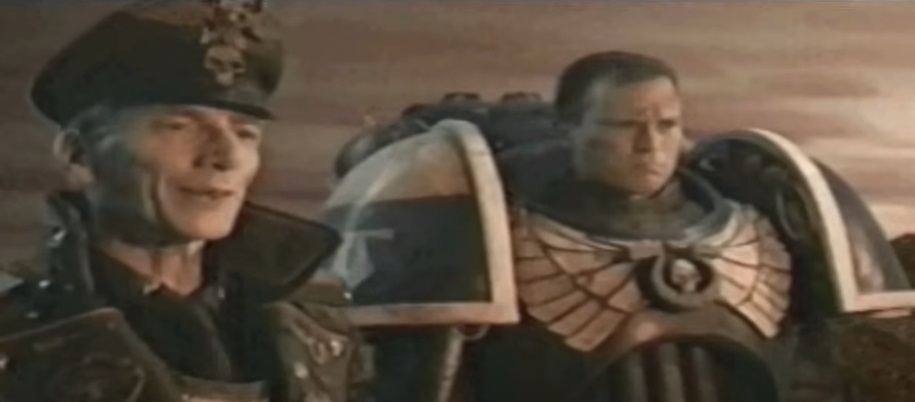
The Fall of Antirrum, by Tom Lauten
In 1996, Games Workshop released a live-action film called Inquisitor. It was reputedly compiled from some footage put together as a movie pitch from Tom Lauten and Bright Light Studios, the studio that would go on to create the FMV cutscenes for the video game Final Liberation: Warhammer Epic 40,000. They also had an impressive body of work in Hollywood, contributing practical effects for Nightmare on Elm Street, Night Breed, Critters, and Poltergeist 3.
For Inferno!, stills from Bright Light Studios’ work were used to create a one-page battle report. Yes, Chaos Lord Katallus does sort of resemble Oderus Urungus’ grumpy older brother, but this was fairly cutting-edge stuff for gaming in 1996.
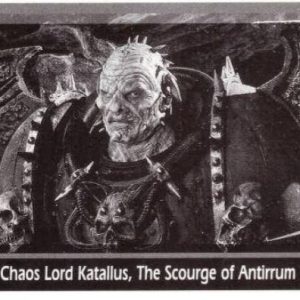
Bloodquest: Meditations, by Gordon Rennie and Colin MacNeil
Although he had plenty of career left ahead of him in 1997, Gordon Rennie was already established in the world of comics when brought aboard to script the Blood Angels story Bloodquest. First published in the Blast! comic magazine in 1991, he soon was doing regular work for 2000 AD. That led to working on stories for Judge Dredd villain Mean Machine in 2000, Rogue Trooper in 2002, and finally in 2004, Dredd himself.
Rennie’s contributions weren’t limited to visual storytelling, but included several short stories and four novels. He also plied his quill in scripting video games, earning a BAFTA nomination in 2006 for Rogue Trooper.
One of Rennie’s colleagues at 2000 AD was artist Colin MacNeil, who had worked on Judge Dredd and Strontium Dog. Here’s an interesting bit of pub trivia: in 1992, MacNeil provided the art for the only DC comic he would ever work on, Legend of the Dark Knight #37. This one-shot story, “Marcy,” also marked the DC debut of a fellow British author who wouldn’t pen another story for DC for five years. That author’s name? Dan Abnett.
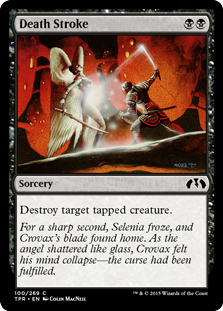
MacNeil also contributed the art for a dozen Magic: the Gathering cards, mainly for Tempest block and Portal.
Other 40K Content
While The Hounds of Winter was the issue’s only short story proper, there was also a one-page preview panel for the comic The Terror of Death as well as a Wanted! poster from the world of Necromunda.
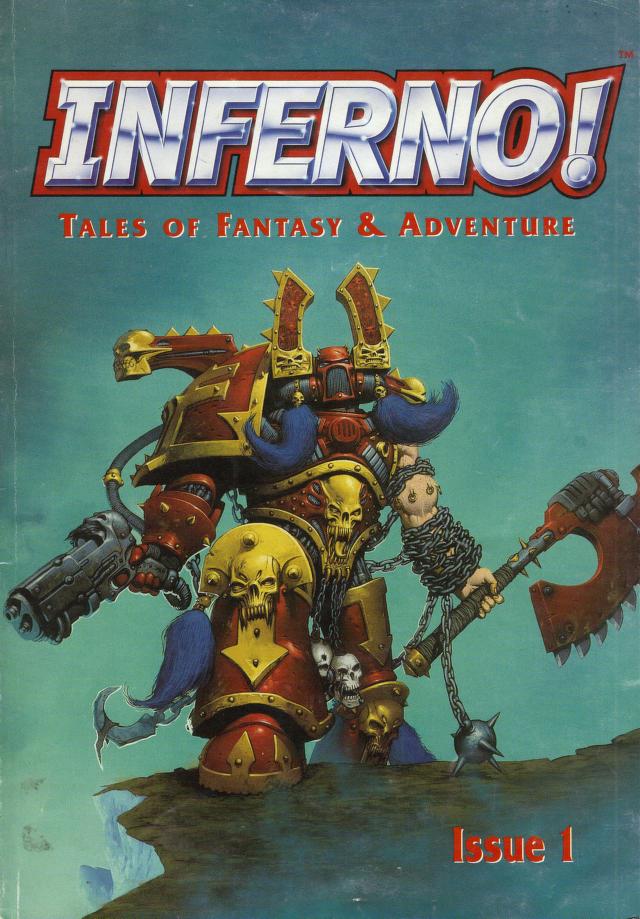
ISSUE #1: JULY 1997
“Abandon all rules ye who enter here,” proclaimed Andy Jones in his editor’s introduction. “This book is packed cover to cover with tales of Fantasy & Adventure. Dive into the INFERNO!”
The official kickoff issue featured a new Gotrek & Felix story from William King, a 3D map of the Siege of Gisoreux, and a Grunnson’s Marauders story from Andy Jones, all for Warhammer Fantasy. Those wanting 40K content had plenty in store of them as well, and not just the brilliant cover of Khârn the Betrayer by Kev Walker.
Like so many other Warhammer artists, Walker came up with 2000 AD where he worked on featured characters like Judge Dredd, Judge Anderson, and Rogue Trooper in addition to being a full-time with Games Workshop. He also was the concept artist for 1995’s Judge Dredd movie.
This portrait of Khârn had been previewed in Issue #0, but now stood revealed in all its glory.
Salvation, by Jonathan Green
Green had contributed the Fantasy story for the preview issue of Inferno!, and now was back in the debut with one for Warhammer 40,000.
In Salvation, a grievously wounded and amnesiac Ultramarine is nursed back to health by a farming community. He joins the community, gladly toiling in the fields to repay their kindness until some months later, he is asked to investigate some attacks on outlying homesteads. What he finds will bring his memories- and his duty- crashing back.
The Demon Bottle, by Alex Hammond
Hammond was an Australian writer (having emigrating from South Africa as a child), who had done some work for White Wolf. He’d landed a successful pitch for a Skaven supplement for Warhammer Fantasy Roleplay, which brought him to the attention of Marc Gascoine.
The Demon Bottle was “my first-ever published story and a big thrill at the time,” he recounted during an interview with Track of Words.1 “I do remember hammering it out in one sitting and just pushing a kind of gritty, visceral feel. There’s something impersonal about miniature gaming, I wanted to make it more emotive, more sensory of what it would be like to live in that world in those conditions.”
In this story, a pest exterminator spends his days at the bottom of the bottle dreaming of a better life. That is, until the day his debts are called in, and he’ll find himself chasing much bigger quarry.
These days Hammond is following a similar trajectory as Neil McIntosh, making the leap from speculative fiction to crime and suspense2.
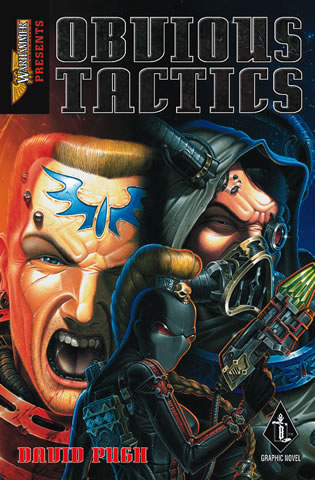
Obvious Tactics Episode One, by Dave Pugh
Pugh had started freelancing for comics on the side in 1977 to supplement a career in advertising, making the jump fully into the medium seven years later. Another artist who’d cut his teeth at 2000 AD, Pugh was an illustrator for strips featuring Sláine, the Celtic barbarian. He also worked on a number of Disney and SEGA comics. Later in his career he was a colorist for a football-themed comic in the Daily Mirror.
Obvious Tactics features members of the Blood Angels Chapter, who partner with a mysterious Callidus Assassin to fight Nurglite cultists on a world in rebellion. Consisting of just a single page in the inaugural issue, the ball doesn’t move very far forward.
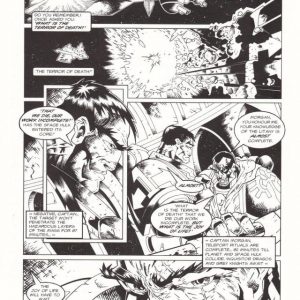
The Terror of Death, by Logan Lubera and Wayde Zalken
Canadian artist Logan Lubera already had a promising career arc when his story landed in Inferno!, working with Image Comics. He would go on to work for Marvel Comics, Blizzard, and Dark Horse as well. Currently he is a Creative Lead for Netflix’s Magic: the Gathering animated series.
His co-writer Wayde Zalken is currently a Senior Writer for video game company Funcom, where he served as narrative designer for 2019’s Moons of Madness.
In The Terror of Death, Dark Angels confront Genestealers- and heresy- aboard a derelict space hulk.
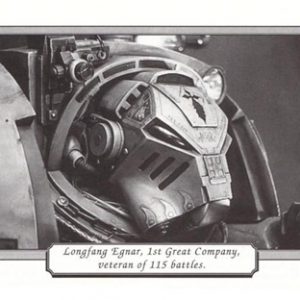
Other 40K Content
Bright Light Studios was back with some more live-action stills, this time highlighting Space Wolves veterans of Operation Stormfrost. Not quite as campy as the Chaos Lord, Longfang Egnar in particular looks straight out of what you’d want Terminator armor to look like.
Finally, there’s a character profile of an Eversor Assassin by the name of Tormentius, tasked with eliminating Lord Saegius Mindblighter on the planet Uphrateus. Two centuries ago the Eye of Terror engulfed Euphrateus, but it has now receded. Valiant Astartes of the Sentinels of Uphrateus Chapter have managed to continue their resistance against Mindblighter and his Word Bearers, but a little extra wetwork would see the job through.

ISSUE #2: SEPTEMBER 1997
Orion by Geoff Taylor graced the cover of the sophomore issue. A prodigious artist for Games Workshop, his art has fronted loads of White Dwarf and Black Library book covers, including many Gotrek books as well as the Space Wolves Omnibus. While it was Fantasy’s turn to ‘ride in the front’ for the cover, there was the usual abundance of 40K content within.

Bloodquest, by Gordon Rennie and Colin MacNeil
In Issue Zero’s prologue, we found Blood Angels Captain Leonatos meditating to himself as he awaited trial. Now as the story kicks off in earnest, we learn the reason for the trial- and its punishment.
Ordered to hold an Astronomican station from a horde of Orks while reinforcements could arrive, Leonatos succeeded- but at too dear a cost. 90% casualties, and the loss of a precious Legion relic stolen by the Orks. Banished from the Legion, Leonatos’ only hope of redemption comes from recovering the lost Sword of Belarius.
This would be the last appearance of Bloodquest in the pages of Inferno!, as it would be shifting vehicles to the Black Library’s comic magazine Warhammer Monthly debuting the following year.
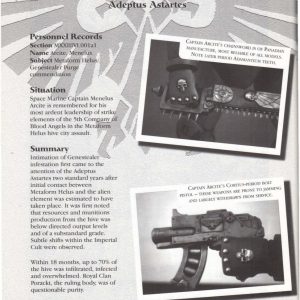
From the Archives of the Blood Angels, by Tom Lauten
More live-image work from Lauten and Bright Light Studios here, with a a tribute to a fallen Blood Angel who valiantly slew a Genestealer Broodmaster in single combat before succumbing to his injuries.
The Black Pearl, by Chris Pramas
Pramas’s involvement with the Black Library is fairly modest- he authored only two short stories- but his history in the gaming space is significant. The founder of Green Ronin Publishing, Pramas has had a hand in design for Dungeons & Dragons, the Dragon Age RPG, and the Second Edition of Warhammer Fantasy Roleplay. Green Ronin turns 25 this year, and recently released an RPG for The Expanse.
In Black Pearl, Dark Angels Interrogator-Chaplain Uzziel hunts a lost relic on an Eldar world, but the relic isn’t what it seems.
Tenebrae, by Mark Brendan
Brendan’s stint with the Black Library would be similarly modest, also consisting of two short stories. The first of these, Tenebrae, concerns the musings of a planetary governor of a world being invaded by the legions of Chaos, and would go on to see publication in 1999’s Into the Maelstrom anthology.
Brendan would never stray far from gaming and science fiction, from releasing a series of self-published novels to contributing to the Realms of Terrinoth RPG from Fantasy Flight Games. He’s also had what must be the world’s worst luck with working on amazing-sounding video games that have ultimately for one reason or another never left development, including titles for Warhammer, Judge Dredd, and A Quiet Place3.
Obvious Tactics Episode Two, by Dave Pugh
After a battle-brother falls to an explosive trap, Blood Angels Sergeant Antenor and Librarian Troilus must contend with an onrushing horde of Chaos cultists alone. Antenor’s solution is…unorthodox.
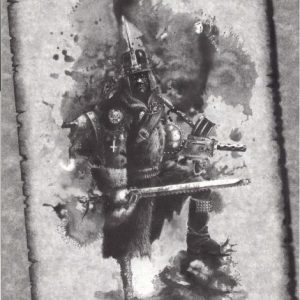
Other 40K Content
The final bit of content in this issue is a character profile of the traitorous warlord Baldo Umbaldi, supplied by John Blanche and Ian Pickstock. Blanche is another of the legends of Games Workshop, whose artistic work started with the cover art of White Dwarf issue #4 (December 1977/January 1978). He continued to contribute to the company, including the cover art for the UK edition of Dungeons & Dragons, and by the mid-80’s he had come aboard full-time as the art director. Blanche retired from Games Workshop in 2023 with an unshakeable legacy of visual contribution to the properties.
Like Blanche, Pickstock was an employee of Games Workshop but in the game design department. He worked there for seven years, leaving in 2000 and migrating towards video game design. Among the works Pickstock contributed to are the Warhammer 40,000 3rd Edition Rulebook and the Imperial Guard and Assassins Codices for 2nd Edition.

ISSUE #3: NOVEMBER 1997
Wayne England’s Night Lord heralded the arrival of Issue #3, and the final release of 1997. England passed away in 2016 at the age of 56, but left behind an incredible legacy of visual imagination in the gaming world.4 His art brought life to a number of properties, including Warhammer, Dungeons & Dragons, and Magic: the Gathering.
In addition to the cover, Issue #3 brought our first look at a Black Library legend.
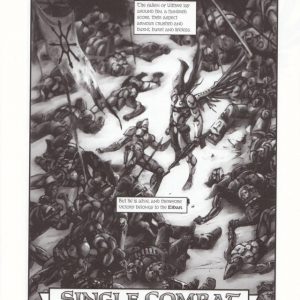
Single Combat, by Dan Abnett and Kev Hopgood
It is hard to understate the impact of Dan Abnett on the body of work of the Black Library, as he has been responsible for creating so many of the most memorable characters and stories in the canon from Gaunt’s Ghosts to Eisenhorn, Horus Rising to The End and the Death. He is not only one of the earliest writers, but also one of the longest-running (his long-awaited Interceptor City just released in hardcover last February following a December Mega-Edition).
At this time of his career, Abnett was already an established voice in comics working mainly with Marvel and 2000AD- and on the brink of adding DC. His body of work already read like a who’s-who of science fiction and superheroism, writing for characters like Doctor Strange, Iron Man, Doctor Who, The ThunderCats, Punisher, The Real Ghostbusters, The Transformers, Judge Dredd, Strontium Dog, Rogue Trooper, and Sinister Dexter (which he co-created).
Abnett appears on-scene for Inferno! in issue 3 with two stories centered around Elves/Eldar. Gilead’s Wake is a Fantasy story with an established character, the doomed warrior Gilead Lothain, while Abnett also provides the script for the comic Single Combat, seeing an Eldar pitted against a World Eater Dreadnought.
It was the next issue- the Christmas Issue (released in January)- that would see the genesis of one of Abnett’s most well-known and loved creations, Gaunt’s Ghosts.
Like Abnett, Hopgood also had a background that included 2000 AD and Marvel Comics UK. He had the lead artist position for Iron Man in the early 90’s and was the co-creator of the character War Machine (played by actor Don Cheadle in the movies). His continuing work in comics includes a number of Warhammer titles, including Darkblade (with Abnett) and Defenders of Ultramar (with Graham McNeill).
The Emperor’s Grace, by Alex Hammond
Hammond had another 40K story in 1997, featuring a Commissar and a Catachan Lieutenant- always fast friends, those- making common cause against the Eldar. Like many of these early Inferno! stories it would be collected and published two years later in the Into the Maelstrom anthology.
Bad Spirits, by Jonathan Green
Another Necromunda offering from Jonathan Green, this issue’s tale concerns a ratskin camp under attack by a mysterious monster. This story also marked the debut of bounty hunter Nathan Creed, of which Green would later write:
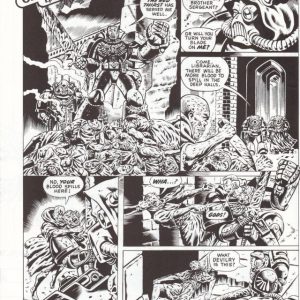
Obvious Tactics Episode Three, by Dave Pugh
Blood Angels Sergeant Antenor and Librarian Troilus have fought back the horde of Chaos cultists- for now. A blade from behind nearly claims Antenor- but who is the mysterious savior who intervened?

From the Archives of the Blood Angels II, by Tom Lauten
Rather than focusing on a single character, Lauten this time chronicles a Blood Angels action at the Metaform Helus Hive on the petro-chemical world of Holbrent IV. A Genestealer infestation! Can the Astartes of the strike cruiser Sanguis Blade handle it on their own?
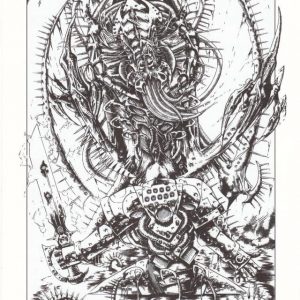
Other 40K Content
Artist Jeff (alternately ‘Jef’) Waye contributed Marine vs Lictor for this issue. Waye has also contributed interior art to gamebooks like White Wolf’s Tome of Horrors 2 and done coloring and lettering work for comics publisher Dark Horse’s Star Wars run.
In addition, Logan Lubera provided a schematic of a Leman Russ ‘Demolisher’ Siege Tank, and Percy Melbye gave the world of Necromunda some visual representation with the illustration Escher Gangers.
In Our Next Installment
We can now close the book on 1997, the inaugural year of the Black Library. 1998 is another year filled with periodicals- both Inferno! and the debut of Warhammer Monthly- but these played an important role in laying the groundwork for the Black Library we know and love today.
As for the books, the books are on the horizon.
References
- Forgotten Texts: Alex Hammond Talks The Demon Bottle – Track of Words
- We covered McIntosh here, in our inaugural piece: In the Beginning: The Origins of the Black Library | Goonhammer
- Video Games | MB Freelance
- Mike Linnemann, one of the Magic: the Gathering’s best-known art columnists, eulogized him here: Wayne England Passes Away | Article by Vorthos Mike
- Jonathan Green, Author: My short stories #3: Bad Spirits
Have any questions or feedback? Drop us a note in the comments below or email us at contact@goonhammer.com. Want articles like this linked in your inbox every Monday morning? Sign up for our newsletter. And don’t forget that you can support us on Patreon for backer rewards like early video content, Administratum access, an ad-free experience on our website and more.
